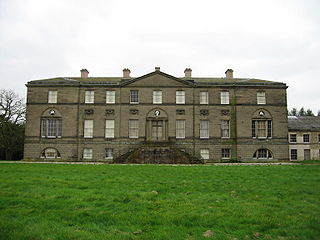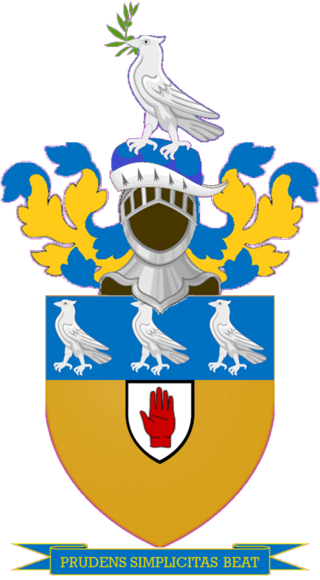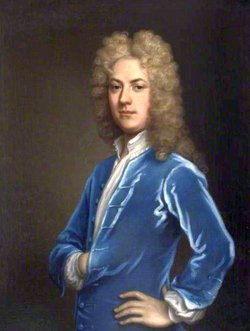
Lamport Hall in Lamport, Northamptonshire is a fine example of a Grade I listed building. It was developed from a Tudor manor but is now notable for its classical frontage. The Hall contains an outstanding collection of books, paintings and furniture. The building includes The High Room with a magnificent ceiling by William Smith. It also has a library with 16th-century volumes and an early 19th-century cabinet room with Neapolitan cabinets which depict mythological paintings on glass. It is open to the public.

The Broughton, later Broughton-Delves, later Broughton Baronetcy, of Broughton in the County of Stafford, is a title in the Baronetage of England. It was created on 10 March 1661 for Sir Brian Broughton, of Broughton Hall, near Eccleshall, Staffordshire, High Sheriff of Staffordshire from 1660 to 1661 and the member of an ancient Staffordshire family.

The Baronetcy of Gresley of Drakelow was created in the Baronetage of England on 29 June 1611 for George Gresley of Drakelow Hall, Derbyshire who was later High Sheriff of Derbyshire and Member of Parliament for Newcastle-under-Lyme.

The Frederick Baronetcy, of Burwood House in the County of Surrey, is a title in the Baronetage of Great Britain. It was created on 10 June 1723 for John Frederick of Burwood House in the southern half of Walton-on-Thames which later became Hersham.

The Isham Baronetcy, of Lamport in the County of Northampton, is a title in the Baronetage of England.

Sir Charles Edmund Isham, 10th Baronet was an English landowner and gardener based at Lamport Hall, Northampton. He is credited with beginning the tradition of garden gnomes in the United Kingdom when he introduced a number of terracotta figures from Germany in the 1840s. Nicknamed "Lampy", the only gnome of the original batch to survive is on display at Lamport Hall and insured for £1 million.
Isham is a surname. Notable people with the surname include:

Sir Justinian Isham, 2nd Baronet was an English scholar and royalist politician. He was also a Member of Parliament and an early member of the Royal Society.

Rev. Euseby Isham, D.D. was an English academic administrator at the University of Oxford.
William Lewin or Lewyn of London and Otterden, Kent, was a college fellow, tutor, ecclesiastical lawyer, and judge. He also served three times as a member of parliament for Rochester.

Sir Thomas Isham, 3rd Baronet of Lamport is known for a diary he wrote from 1671 to 1673 of his observations as a teenage member of the English aristocracy.

Sir Justinian Isham, 4th Baronet was an English landowner and Tory politician, who sat in the House of Commons almost continuously from 1685 until his death in 1730. He was the longest serving member, later termed Father of the House, from 1729 to 1730.
Zacheus Isham (1651–1705) was a Church of England clergyman and religious author.

Sir Gyles Isham, 12th Baronet was an English aristocrat, actor, and historian.

Sir Justinian Isham, 5th Baronet, of Lamport, Northamptonshire was a British Tory politician who sat in the House of Commons from 1730 to 1734.

Sir Edmund Isham, 6th Baronet was a Member of Parliament for several successive terms during the reigns of Kings George II and George III of Great Britain.
Elizabeth Isham (1609–1654) was an English intellectual, herbalist, and diarist. She is best known today for her two autobiographical diaries, which are among the earliest known examples of autobiography written by an Englishwoman. Although a wealthy woman, Anne Cotterill has said that for Isham her "mind was more to her than wealth".

Sir Justinian Isham IV was the 7th Baronet of Lamport and served in 1776 as High Sheriff of Northamptonshire.

Sir John Henry Seale, 1st Baronet (1780–1844) of Mount Boone in the parish of Townstal near Dartmouth in Devon, was a Whig Member of Parliament for Dartmouth in 1838. He was created a baronet on 31 July 1838. He owned substantial lands in Devon, mainly at Townstal and Mount Boone. Together with the Earl of Morley of Saltram House near Plymouth, he built several bridges in Dartmouth, most notably the Dart crossing. Arthur Howe Holdsworth's, the previous Member of Parliament in Dartmouth, influence over the pocket borough of Dartmouth ceased after the 1832 Reform Act and subsequently he was in competition for that parliamentary seat with John Seale, who won the seat.
The Reverend Sir Philip Grey-Egerton, 9th Baronet, was a 19th-century Anglican clergyman and landowner, who succeeded to his family baronetcy and served as Rector of Tarporley and Malpas, Cheshire.














